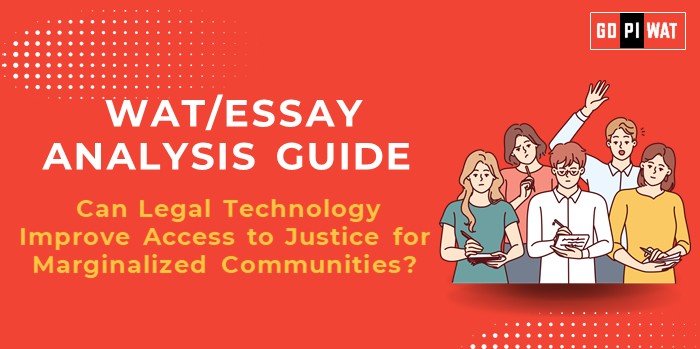📋 Written Ability Test (WAT)/Essay Analysis Guide: Can Legal Technology Improve Access to Justice for Marginalized Communities?
🌐 Understanding the Topic’s Importance
Legal technology’s potential to democratize access to justice aligns with broader economic and social equality goals. It intersects with critical issues such as poverty, systemic inequities, and the digital divide, making it a pivotal subject for governance and policy discussions.
📝 Effective Planning and Writing
- ⏱️ Time Allocation (30 minutes):
- Planning: 5 minutes
- Writing: 20 minutes
- Review: 5 minutes
- 📋 Essay Structure (500 Words):
- Introduction (70 words): Contextualize with a powerful statistic or contrast.
- Body Paragraphs (350 words): Achievements, challenges, and future outlook.
- Conclusion (70 words): Provide actionable recommendations or a balanced view.
🎯 Introduction Techniques for Essays
- 📊 Contrast: “While AI-driven tools reduce legal costs, the digital divide leaves millions without access.”
- 🔧 Solution-Based: “Legal tech is the key to justice for all, provided its adoption is inclusive and widespread.”
- 📜 Timeline: “From virtual courts to AI research, legal technology has evolved to bridge the justice gap, but challenges persist.”
📊 Structuring the Essay Body
1. Achievements:
- ⚖️ e-Courts in India have expedited hearings, reducing case backlogs.
- 💻 Online Dispute Resolution (ODR) platforms have saved significant legal costs.
2. Challenges with Comparisons:
- 🌐 Barriers like digital illiteracy and limited rural internet infrastructure.
- 🌍 Global examples, such as Estonia’s inclusive digital justice system, highlight gaps India can address.
3. Future Outlook:
- 🤝 Leveraging AI for legal research and case analysis.
- 📈 Building partnerships between government and private sectors to expand reach.
- 📜 Introducing policy changes to standardize and secure legal tech adoption.
📖 Concluding Effectively
- ⚖️ Balanced Approach: “Legal tech offers hope for justice equity but demands robust infrastructure and awareness campaigns.”
- 🌍 Global Comparison: “As seen in Estonia, digitization can revolutionize justice systems if inclusivity remains a priority.”
💡 Recommendations for Sustainable Progress
- 📶 Expand rural digital infrastructure to ensure widespread access.
- 📚 Promote digital literacy programs tailored for marginalized groups.
- 🔐 Enforce data protection and cybersecurity on legal tech platforms to ensure trust and adoption.
📄 Sample Short Essays (100 Words Each)
1. Balanced Perspective: “Legal technology can revolutionize access to justice by reducing costs and delays. However, marginalized communities often face barriers like digital illiteracy and inadequate infrastructure. Addressing these challenges through public-private collaborations and targeted literacy programs can ensure equitable outcomes.”
2. Solution-Oriented: “Integrating legal technology with grassroots efforts is key to empowering marginalized groups. Expanding digital infrastructure and enhancing literacy are essential steps to bridge the access gap and make justice more inclusive.”
3. Global Comparison: “Estonia’s e-governance model demonstrates how digital systems can enhance legal accessibility. India can replicate this by scaling e-Courts and ensuring rural connectivity for marginalized communities.”


